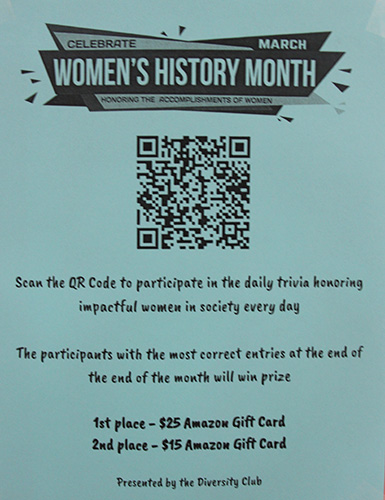Pine Bush High School students are learning about extraordinary women this Women’s History Month thanks to the Diversity Club. Alexa Dagele and Alicia Parker, co-advisors of the club, along with student Hanin Mohammed, have devised a full month of trivia questions, all relating to impactful women. They have posted flyers throughout the high school with QR codes on them. Each day there is a new question, so students are encouraged to access the QR code daily.

“Our hope is that students will Google the person to learn about them and answer the question,” said Ms. Dagele. “That has been the case! We have very good participation.”
In addition to the knowledge students are gaining, it will pay off. The two students who have the most correct answers will each win an Amazon gift card.
(The Diversity Club meets on Wednesdays.)
Ever wonder how Women’s History Month came about? Officially, Congress followed many states to declare March Women’s History Month back in 1987. But it took a lot of effort over decades on the backs of many women to get to that point.
In the 1950s a group of feminist historians began to search for women in history. It wasn’t easy to find. History books did not include many women, with few exceptions. In the last 1960s, Gerda Lerner began teaching women’s history on the college level. She joined Sarah Lawrence College where they were creating the nation’s first master’s program in Women’s Studies.
By the late 1970s, a high school teacher in northern California, Molly Murphy MacGregor who had studied women’s history in college, put together a slide show on the history of American women in politics, environmental activism and the abolitionist movement. She got a great response and soon joined the Sonoma County Commission on the Status of Women, which had been created and tasked with eliminating gender discrimination and prejudice.
One of the group’s goals was to have Sonoma County schools comply with the landmark law Title IX, which protects people from discrimination based on sex in any educational program that receives federal funding. The lack of women’s stories in educational materials constituted a violation of Title IX. The Commission proposed a women’s history week to coincide with International Women’s Day on March 8. The week kicked off with a parade, presentations and the distribution of materials for local schools.
That local celebration elicited a landslide of interest from women around the country. The group became the National Women’s History Project (now the National Women’s History Alliance) and equipped teachers across the country with curricula on women’s history achievements.
In 1980, President Jimmy Carter declared the first National Women’s History Week from March 2-8. Many states expanded it and declared March Women’s History Month and in 1987, it was a national declaration.
The motto of the National Women’s History Alliance is “Our history is our strength.”
